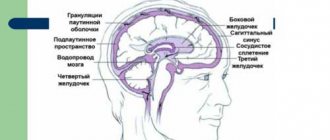Article:
Such a phenomenon as sleepwalking is not so rare in children. Sleep disturbance leads to the child getting out of bed, walking, and performing some actions. He does this unconsciously, and the next morning he doesn’t remember anything. Parents do not always understand the reason for this behavior, sometimes even consider it a mystical phenomenon. But there are very real reasons why it manifests itself in children. First of all, sleepwalking is explained by the peculiarities of the development of the children's nervous system. Most often, in adulthood, sleep improves. But sometimes we are talking about neurological pathology.
What is sleepwalking
Sleepwalking is also called somnambulism (or “sleepwalking”). Most often, this sleep disorder is observed in children over 4 years of age. Some of them experience periodic episodes of sleepwalking even in adolescence. This deviation can be combined with other types of parasomnia (sleep disorder). For example, a sleeping person talks and laughs under the impression of previously experienced emotions. Somnambulism has a similar nature to such manifestations as involuntary urination at night (enuresis) or nightmares.
Sleep disorder is due to the fact that the child’s brain cannot always adequately perceive the variety of information that enters it. His work continues even at night, when he is supposed to rest. The immature nervous system reacts violently to events that occur during the day, which continue to excite the brain during sleep. Impressed by a scary cartoon or movie, playing on the computer, an unpleasant or joyful meeting, or a quarrel with relatives, the child cannot fall asleep for a long time, and continues to worry in his sleep.
During normal sleep, the work of all parts of the brain, including those responsible for movement, is inhibited. Therefore, muscles relax, energy consumption decreases, and the body rests.
During episodes of sleepwalking in a child, part of the brain centers responsible for perception and awareness of reality is switched off, but the part that regulates physical activity continues to work. The brain sends false signals, and the body reacts to arousal caused by imaginary events.
In conclusion
Sleepwalking in adolescents is not considered a serious pathology, although it cannot be called the norm either. Most often, this condition goes away on its own by the age of 15-16 years.
However, there are cases when children injure themselves while sleepwalking or have serious psychological or physical disorders that provoke somnambulism. In such a situation, you cannot do without medical help.
Remember that even if your child sleepwalks rarely, you should still consult a doctor to avoid serious consequences.
Author: Dasha Pashchenko
Causes of sleepwalking
As you know, people have 2 phases of sleep: slow and fast. During the night they alternate with each other, and this happens 4-5 times.
REM sleep can be superficial. When a person wakes up, he does not remember his dreams. If this phase prevails in duration, then he feels poorly rested and sleep-deprived.
NREM sleep normally lasts longer and occurs in 4 stages, each of which has its own characteristics (drowsiness, gradual shutdown of the brain, transition period and deep sleep). The last stage is the most difficult to awaken a person.
It is at the fourth stage of slow-wave sleep that children may experience manifestations of sleepwalking. Factors that provoke sleepwalking may include:
- strong feelings (both negative and positive);
- fear, fear of the dark, making sleep restless;
- mental stress due to workload at school, additional classes with tutors;
- lack of entertainment and active recreation, which children especially need.
The causes of somnambulism may be more serious. Sleepwalking manifests itself against the background of epilepsy, neuroses, mental illness, and brain damage. Brain function can be impaired as a result of head injury, tumor formation, as a consequence of meningitis, encephalitis and some other diseases. The cause of impaired brain activity in a baby is also infection with worms (they deprive the body of nutrients and, in addition, can penetrate directly into the brain).
Somnambulism is often a phenomenon that is inherited. The performance of involuntary actions during sleep is facilitated by a noisy environment surrounding a sleeping baby, sudden switching on of lights, or sleeping in a lit room.
The phenomenon was called “sleepwalking”, as it was noticed that the light of the moon can affect the sleeping person. Sleepwalking is more common during the full moon.
A similar phenomenon occurs more often in boys. In girls, episodes of sleepwalking are sometimes observed in connection with the appearance of menstruation and the corresponding hormonal changes in the body. The occurrence of sleep disturbances is facilitated by the presence of certain pathologies in the child, such as cardiac arrhythmia, asthma, night cramps, apnea (periodic stops of breathing).
Why do teenagers sleepwalk?
The nervous system of a modern child aged 12-16 years is susceptible to the negative influence of external factors, such as a large information flow, high educational loads and other phenomena. Emotional stress against the background of hormonal changes may well become a catalyst for sleepwalking. Scientists also found out that some people have a genetic predisposition to this condition.
It is impossible to say exactly which genes or one specific gene leads to somnambulism. However, there is a version that the causes of the disorder are hidden in the adenosine deaminase gene, which is responsible for the phase of slow (deep) sleep.
Regardless of whether a teenager has people in their family who suffer from sleepwalking or not, certain conditions must be created for the disorder to manifest itself. The causes that provoke this condition may be completely harmless or require immediate treatment. Let's look at them in more detail:
- An incompletely formed central nervous system, which cannot yet fully cope with its functions and sometimes fails in the form of sleepwalking.
- Severe stress, which teenagers experience quite often due to their increased emotionality, can develop due to conflicts in the family or team, problems with studies, change of place of residence and other negative factors.
- Insomnia, which occurs for a variety of reasons. This should be of particular concern to parents, since lack of night rest leads to serious health problems.
- Neuroses of various types, they can manifest themselves in the form of hysteria, neurasthenia or twilight stupefaction as a result of hysteria.
- Epilepsy, which is one of the most serious causes of sleepwalking. You can recognize it by the fact that in a dream the child often swallows saliva, smacks his lips, twitches, rises sharply from the bed, and mechanically rubs his hands.
- Congenital diseases of the nervous system and psyche that appear at an early age.
- Previously suffered traumatic brain injuries, which may result in irreversible disturbances in the activity of the central nervous system.
- Neuroinfections leading to pathological processes in the brain.
- Helminthiasis is in the terminal stage, when toxins released by worms poison the entire body and lead to damage to the nervous system.
What is the danger of somnambulism?
Involuntary and uncontrollable actions performed by a sleepwalker lead to dangerous situations. When getting out of bed, he may trip or hit himself, pick up dangerous objects (scissors, a knife), or touch an electrical wire.
Warning: It is dangerous to leave a window or balcony open (the sleeper may fall out). A sleepwalker is able to open the door and go outside, into an unfamiliar place. A teenager is able to get into a car and drive away mechanically. Accordingly, a danger is created not only for himself, but also for the people around him.
Parental behavior
In cases where sleepwalking does not pose a threat to the life and health of a teenager, treatment is not required. Sleepwalking can continue until the end of the maturation period; in only 1% of people it remains for life.
In order for the period of sleepwalking in a child’s life to pass without psychological and physical trauma, parents must make every effort to ensure a comfortable and safe environment in the family.
To do this you need to follow these rules:
- Become your child's best friend. If a teenager shares his experiences with his parents, feels their support, knows that no one will judge or scold him, the nervous system will be strong and resilient. Building trust will have a positive impact on your night's rest.
- Take the TV, computer and tablet from your child’s room. Scientists have found that children who watch movies before bed, surf social networks or play computer games are more likely to suffer from somnambulism. Explain to your child that the bedroom is a place for relaxation and there should be no household appliances in it that distract from sleep. You may immediately encounter misunderstanding on the part of your child, but be persistent and suggest listening to calm music in the evening or reading light literature as an alternative.
- Take care of your child's nervous system. Teenagers perceive all conflicts that occur in the family especially acutely, and this negatively affects the functioning of their nervous system. In order for attacks of sleepwalking to occur less frequently or disappear altogether, you need to protect the child from quarrels, fights, intrigues and other troubles. Confidence in the kindness and devotion of relatives, a calm and warm microclimate in the family will help overcome the disorder.
- Prevent the negative consequences of sleepwalking. During an attack of sleepwalking, a teenager may go outside in pajamas on a frosty night, fall down the steps, and injure himself. Parents can prevent all these consequences. Remove from the nursery all objects that could accidentally mutilate yourself, close all windows and doors tightly at night so that the sleepwalker cannot get outside. Tie a bell to the front door of your child's room, so you will wake up when the somnambulist comes out, and you can protect him from falls and injuries.
- Use relaxation techniques. Encourage your child to take a bath with essential oils of geranium, sandalwood or lavender before bed. You can also scent his room with these oils; they very well relax the nervous system and set him up for a deep, long sleep. You can put an aromatic bag of hops under the sleepwalker’s pillow. An hour before rest, it will be useful to drink a cup of soothing tea; it can be prepared from chamomile, lemon balm and other herbs.
- Make the right diet. Heavy, fatty, spicy, spicy foods, sweets, chocolate, strong tea or coffee should be excluded from the dinner menu. Your teen should eat healthy but easily digestible foods so that their digestive system can get a full night's rest. The last meal should be no later than 2-3 hours before bedtime.
- Organize a clear sleep and wake schedule. Putting a teenager to bed at 22.00-23.00 is a real problem. However, you can cheat, for example, invite your child to go jogging together in the morning, and set the alarm for 7.00. Just a few days of such early awakenings will help the teenager fall asleep earlier, and soon his body will get used to the routine.
Manifestations and symptoms of sleepwalking
Uncontrolled sleep behavior leads to movements of varying complexity. In the best case, the sleeper assumes a sitting position, but he can also get out of bed, sort through toys, change clothes on his own, and go to the kitchen.
The feature is as follows:
- The sleepwalker's consciousness is switched off. Despite this, he is able to move actively and confidently. He automatically answers simple questions, but does not adequately perceive speech addressed to him.
- There is no sense of danger.
- The sleeper moves with his eyes open, but is not aware of what he sees. The facial expression does not change, emotions are not reflected on it.
- Memories of what happened during this time completely disappear.
- The episodes end with the child going back to bed or falling asleep where he finds the end of the episode of somnambulism, and then plunging into normal sleep. An episode of uncontrolled activity can last from 10 minutes to 1 hour. Usually begins 2-3 hours after the child falls asleep.
It is very difficult to wake up a sleepwalker while performing such involuntary actions. In this case, waking up after a loud shout, strong shaking, splashing with cold water can lead to the fact that the awakened person is very frightened, not understanding what is happening, and reacts aggressively.
Somnambulism, sleepwalking, sleepwalking - diagnosis
Diagnosing somnambulism does not present any difficulties for specialists. Sometimes motor automatisms, performed in the absence of consciousness and ending in amnesia (memory loss), indicate their possible connection with epilepsy. Sarklinik observed cases of epilepsy in children who had suffered from somnambulism in the past. Some experts identify a separate form of somnambulism - epileptic somnambulism. A patient may develop an automatic attack at night, which has nothing to do with somnambulism. Patients with epilepsy may also experience somnambulism.
What to do if your child experiences somnambulism
Pediatricians do not consider sleepwalking a serious illness. According to the authoritative opinion of the famous doctor, author of popular programs about children's health, E. Komarovsky, there is no need to worry if such behavior in a child occurs sporadically in a dream, while it is clearly preceded by some specific provoking events. You just need to think about safety measures for the children themselves and those around them.
However, in some cases it is necessary to consult a doctor, especially if the episodes occur frequently, the child looks tired after them, or there are signs of physical and nervous exhaustion.
You should contact a pediatric neurologist or psychiatrist.
There are two phenomena that happen to a child - sleep talking and sleepwalking.
Let's talk about each phenomenon separately.
Dream-speaking
Sleep-speaking is a situation where a child is sleeping and, at the same time, talking. Pronounces different types of words. And also phrases.
In most cases, what the child says is completely incomprehensible. Because the phrases are not pronounced very clearly. The duration of the speaking phase in a dream can vary. Starting from just a few seconds, ending in minutes.
Dream-speaking is a common phenomenon, but not very frequent. It rarely appears in children. And there is practically no danger. Therefore, if a child speaks in his sleep, then you should not be afraid of it.
Sleepwalking
Sleepwalking is when a child wakes up during the night. And begins to perform any physical actions. Sleepwalking occurs when the moon is in full phase.
This phenomenon is most common among males. Guys aged from 4 to 12. But sometimes girls can also suffer from somnambulism. At the same time, it is worth considering that sleepwalking can also appear in teenagers. It all depends on the characteristics of the body.
How are sleep disorders diagnosed?
In order to establish how dangerous the existing phenomenon is in this case, the doctor must know how long the episodes last, how often they are repeated, and what actions the patient performs. The presence of additional manifestations (fainting, headaches, dizziness, other sleep disorders), as well as diseases and provoking factors, is taken into account.
A brain examination using MRI or electroencephalography (a procedure during which electrical impulses emitted by various parts of the brain are recorded) may be prescribed.
An effective method for identifying the causes of sleepwalking is polysomnography. Using sensors installed on different parts of the body and computer data processing, the activity of a sleeping person’s body is studied and deviations from the norm are identified.
Sleepwalking, somnambulism, classification, types, forms
Neurologists, neuropathologists, reflexologists, reflexologists, psychiatrists distinguish 2 main types (forms) of somnambulism - neurotic somnambulism and neurosis-like somnambulism. In our practice, we have encountered cases of sleepwalking that occurred without provoking factors or somatoneurological disorders. The mechanism of development of somnambulism is closely related to the characteristics of the sleep-wake cycle. Sleepwalking often occurs in stages 3 and 4 of non-REM sleep and is caused by dysfunction of the ascending systems of the brain.
Treatment for somnambulism
It is carried out when obvious health problems or pathologies associated with the state of the brain and nervous system are detected.
In the absence of obvious diseases, only recommendations are given on creating conditions for healthy sleep and eliminating factors that provoke the occurrence of disorders. In difficult cases, it is suggested to use hypnosis.
Indications for mandatory drug treatment are:
- the young patient has epilepsy (antiepileptic drugs Felbatol, Depakote are prescribed);
- the appearance of neuroses and depression (sedatives valerian, Novo-Passit, psychotropic drugs are used);
- detection of worms (antiparasitic drugs Pirantel, Dekaris are used).
If it is discovered that sleepwalking in children is a consequence of a brain tumor or head injury, surgical treatment is performed.
What parents need to remember
Of course, it cannot be denied that sleepwalking is a disease. However, in the vast majority of cases, it goes away on its own with the onset of adolescence. If the doctor reassured you and, after a comprehensive examination, did not find any serious disorders in your baby, your main tasks become:
- regular monitoring of the child’s emotional state, as well as his workload, timely consultation with a doctor in case of a negative change in condition;
- ensuring the opportunity for proper rest, especially before bedtime (excluding outdoor and computer games, as well as watching television programs);
- ensuring the safety of the child at the time of such awakenings (under no circumstances should you wake the child, just accompany him and ensure the safety of his progress).
Our specialists
Derevianko Leonid Sergeevich
Head of the Center for Diagnostics and Treatment of Sleep Disorders.
The doctor is a neurologist of the highest category. Vertebrologist. Somnologist. Epileptologist. Botulinum therapist. Physiotherapist. Experience: 23 years.
Tarasova Svetlana Vitalievna
Expert No. 1 in the treatment of headaches and migraines. Head of the Center for the Treatment of Pain and Multiple Sclerosis.
Somnologist.
Epileptologist. Botulinum therapist. The doctor is a neurologist of the highest category. Physiotherapist. Doctor of Medical Sciences.
Experience: 23 years.
Treatment of sleepwalking and other parasomnias in Samara
The First Neurology clinic has accumulated significant experience in the treatment of parasomnias.
More than 10 high-tech techniques are used:
- Different options for transcranial electrical stimulation: Micropolarization of the brain, MDM therapy, electrosleep;
- Transcutaneous electrical neurostimulation "Cefaly";
- Transcranial magnetic therapy;
- Individual psychotherapy;
- Magnetic stimulation of the neuromuscular apparatus of the pelvic floor – correction of nocturnal enuresis;
- Carboxytherapy;
- Acupuncture;
- Chronomagnetic therapy "Multimag";
- Mesoinjection therapy of the collar and lumbar zones with the introduction of vascular protectors;
- Ozone therapy.
Timely and effective treatment of sleepwalking and other parasomnias improves the quality of night sleep, increases daytime activity and performance. A child and an adult can study and work in a team, without being embarrassed by “nightly episodes” and communicate comfortably with peers.
Which doctor should I contact?
If a teenager shows signs of somnambulism, parents should take control of this condition. A one-time occurrence of somnambulism can be attributed to stress or nervous tension. However, if sleepwalking occurs regularly, the teenager should be shown to a specialist. A psychologist, psychotherapist and neurologist can conduct an examination and prescribe effective treatment.
To facilitate the diagnosis, a diary of sleepwalking will help, in which it is necessary to record the duration of the attack and the behavior of the teenager at this moment, as well as the possible causes of the sleep disorder.
Additionally, the doctor may prescribe electroencephalography, ultrasound of brain vessels, MRI or CT. In some cases, consultation with a cardiologist, endocrinologist and other specialists may be required. They will help diagnose the disease that causes the disease.
Deadly Awakening
Sometimes you hear that sleepwalking is a mild, benign disorder. The disease really does not harm children and goes away over time, but adult sleepwalkers themselves are in danger and dangerous to others.
First of all, they do not fully control their movements and can accidentally harm themselves: hurting themselves or burning themselves when preparing food, dropping something heavy, falling down the stairs or walking through a glass door (Fig. 2). There are cases where somnambulists woke up in fear and jumped out of the window. They can destroy the room they are in.
Rice. 2.
The sleepwalking girl depicted in the painting by the Czech artist Maximilian Pirner (1878) is in danger of falling from the ledge. Only real sleepwalkers walk with their eyes open
Sometimes the sleepwalker hits, injures or kills a person who is sleeping or nearby. As a rule, the somnambulist does not look for a victim, but attacks the one who woke him up, scared him or tried to stop him. However, there are exceptions. In 1985, a lot of noise was caused by the incident that occurred with Canadian Kenneth Parks, 23 years old. He fell asleep in front of the TV, then, in a somnambulistic state, left the house and drove his car 18 km to the house of his mother-in-law, whom he stabbed to death. After three years of ordeal, the jury found him not guilty.
Yes, sleepwalkers also drive. If the route is familiar, the trip may be uneventful, but this is not always the case. During the episode, one driver was driving in the oncoming lane and did not respond to the signals of other cars. The collision could not be avoided and three people died.
It is not clear why sleepwalkers kill. As a rule, in reality they did not quarrel with their victim. There is a known case where a man attacked his wife with an ax. Fortunately, she remained alive and later at the trial she told what a wonderful, caring husband she had, simply perfect.
Stories about aggressive sleepwalkers give rise to the ominous image of a somnambulist wandering around with a knife in her hand in search of a victim. However, the state of sleepwalking does not imply bloodthirstiness by default, and murders are extremely rare.











